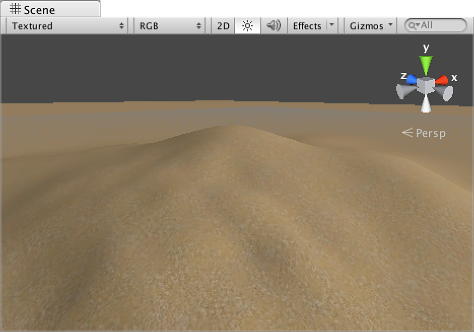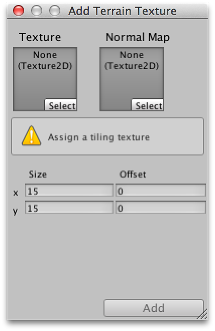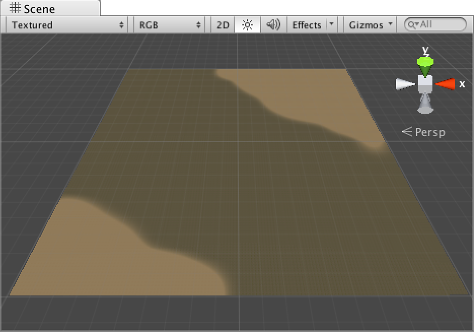Textures
You can add texture images to the surface of a terrain to create coloration and fine detail. Since terrains are such large objects, it is standard practice to use a texture that repeats seamlessly and tile it over the surface (the repeat generally isn’t noticeable from a character’s viewpoint close to the ground). One texture will serve as the “background” image over the landscape but you can also paint areas of different textures to simulate different ground surfaces such as grass, desert and snow. The painted textures can be applied with variable transparency so you can have a gradual transition between grassy countryside and a sandy beach, for example.

Enabling Textures
The paintbrush button on the toolbar enables texture painting.

Initially, the terrain will have no textures assigned for painting. If you click the Edit Textures button and select Add Texture from the menu, you will see a window where you can set a texture and its properties.

You can click the Select button in the corner of the Texture box to see a standard asset browser from which you can choose any texture from your project. The standard assets supplied with Unity include a number of terrain textures that are useful for simple effects (menu: ). You can also assign a normal map for the texture in a similar way.
The Size property (just below the texture boxes) let you set the width and height over which the image will stretch on the terrain’s surface. The Offset property determines how far from the terrain’s anchor point the tiling will start; you can set it to zero to start the tiling right in the corner. Once you have set the texture and properties to your liking, click the Add button to make the texture available to the terrain.
Texture painting
The first texture you add will be used as a “background” to cover the terrain. However, you can add as many textures as you like; the subsequent ones will be available for painting using the familiar brush tools. Below the textures in the Terrain inspector, you will see the usual Brush Size and Opacity options but also an additional option called Target Strength. This sets the maximum opacity value that the brush will build up even if it passes over the same point repeatedly. This can be a useful way to add subtle patches of color variation within a single terrain type to break the monotony of a large, flat area with the same texture tile repeating over and over.
